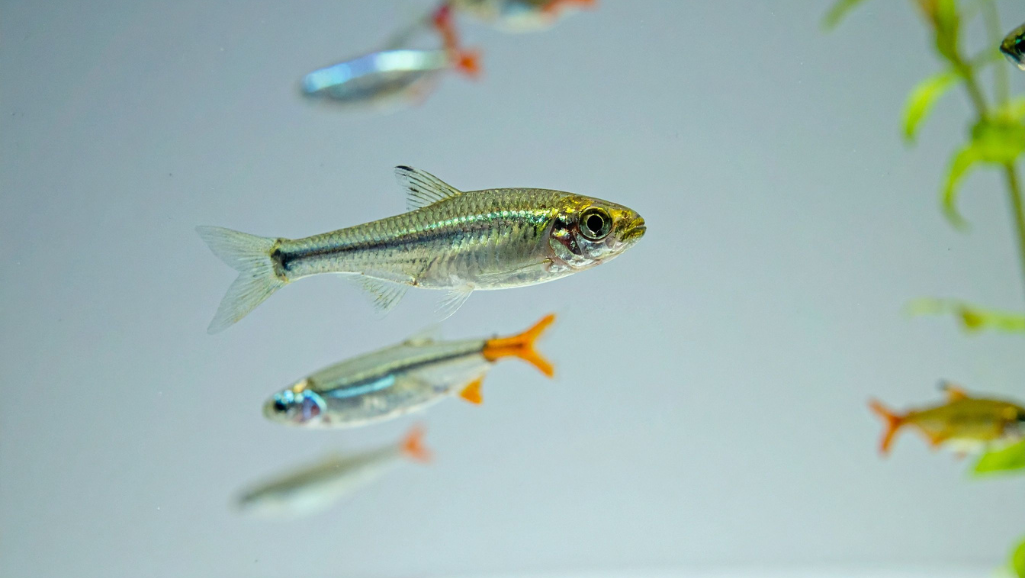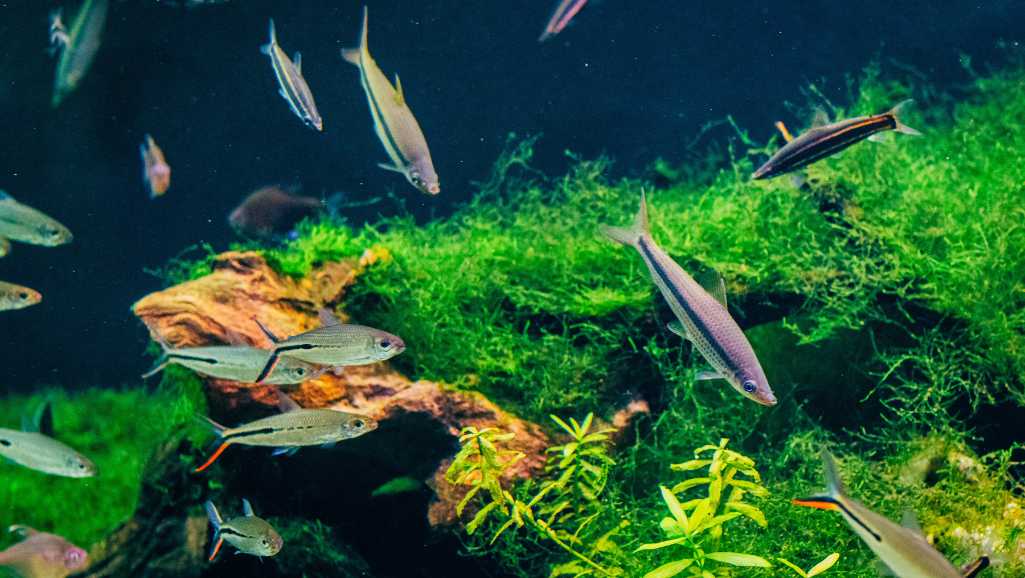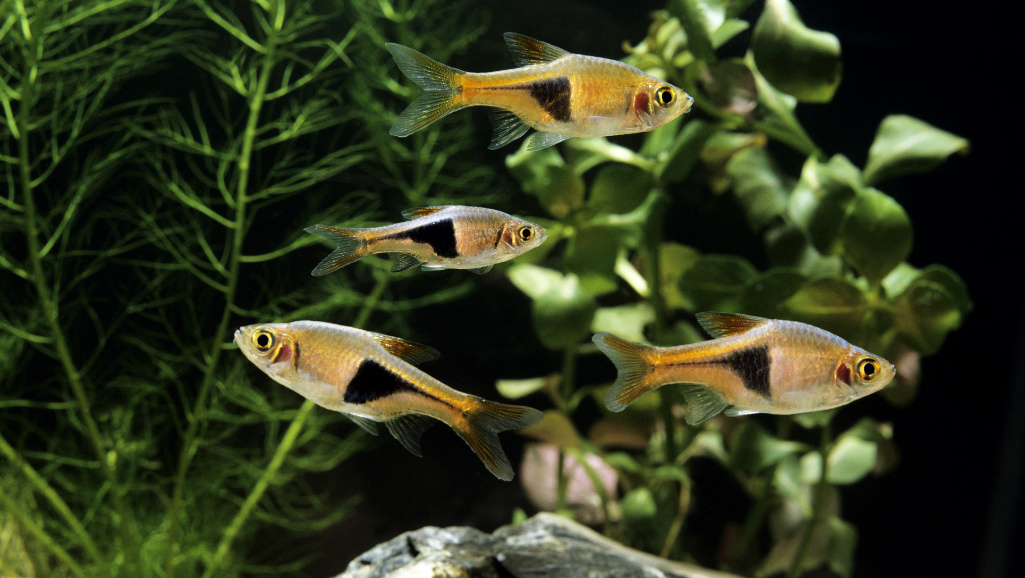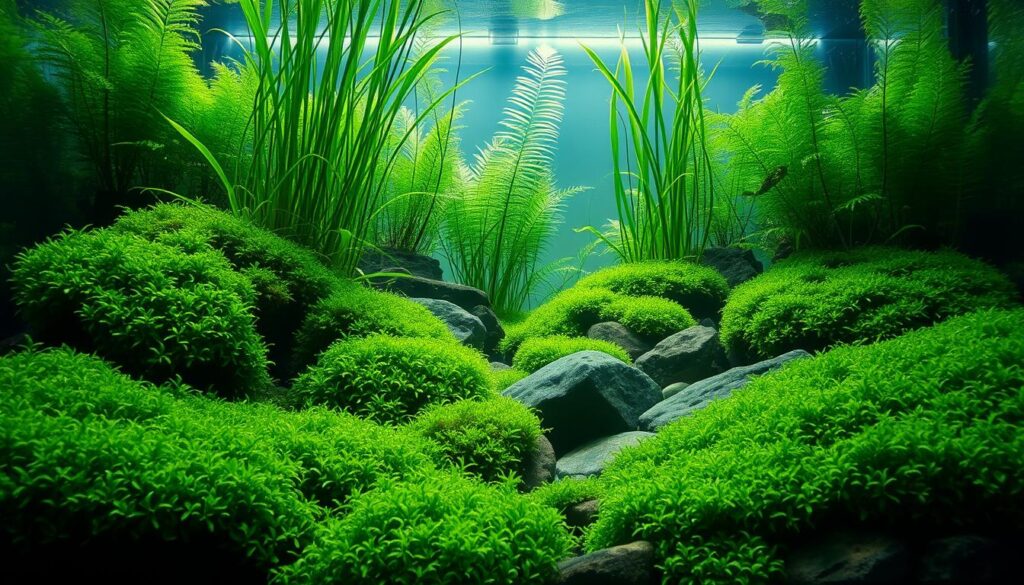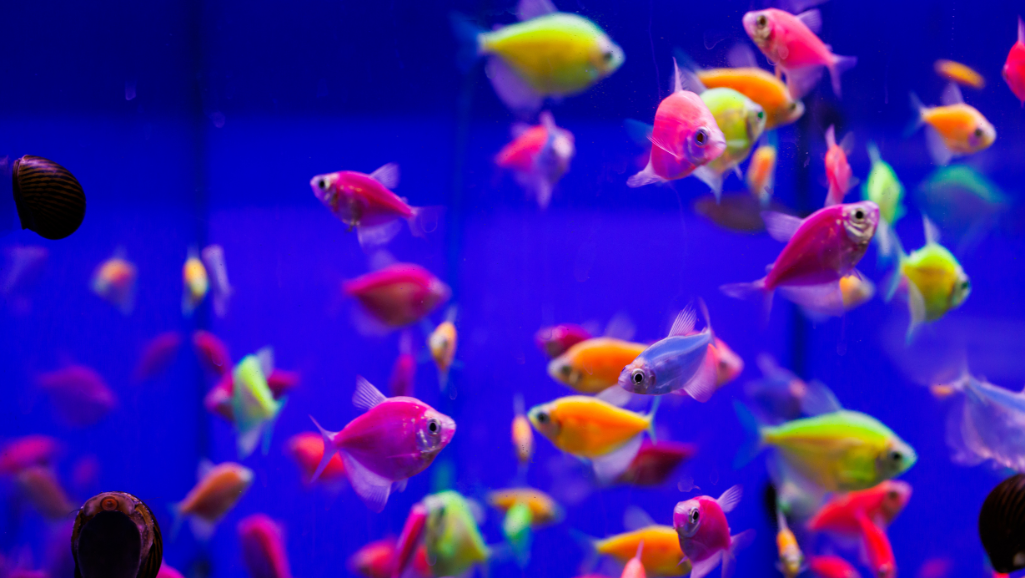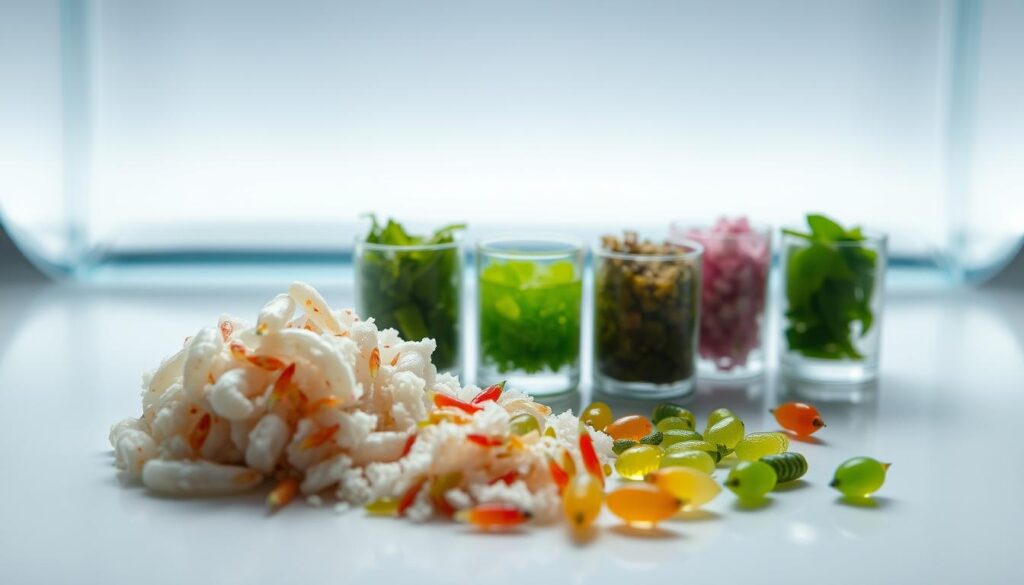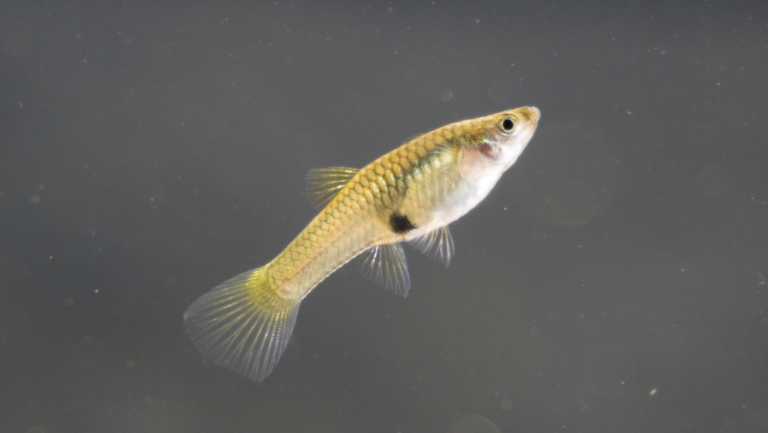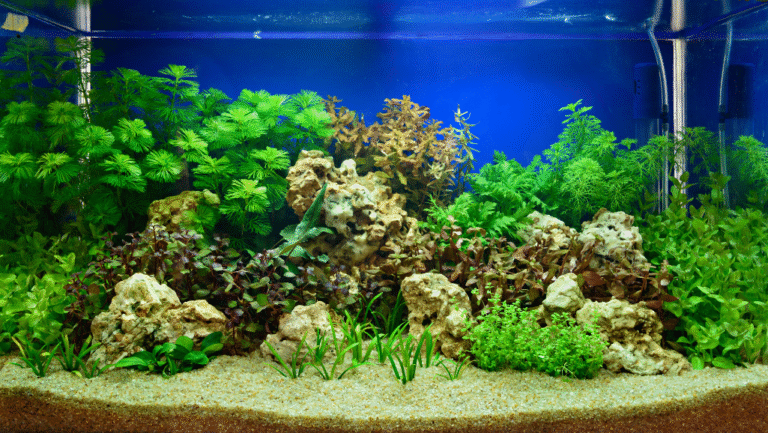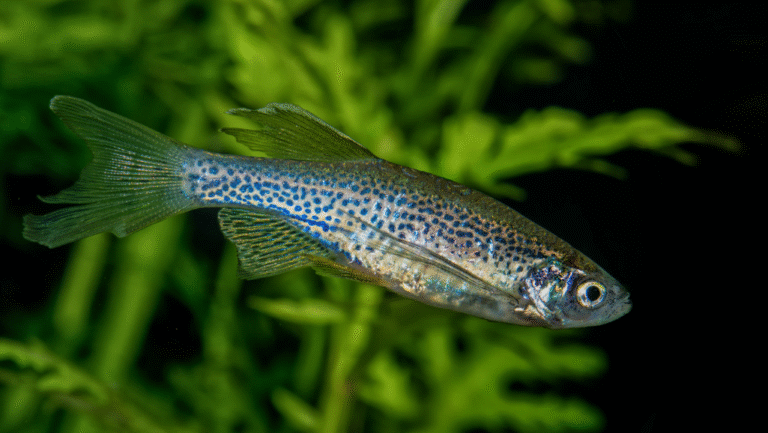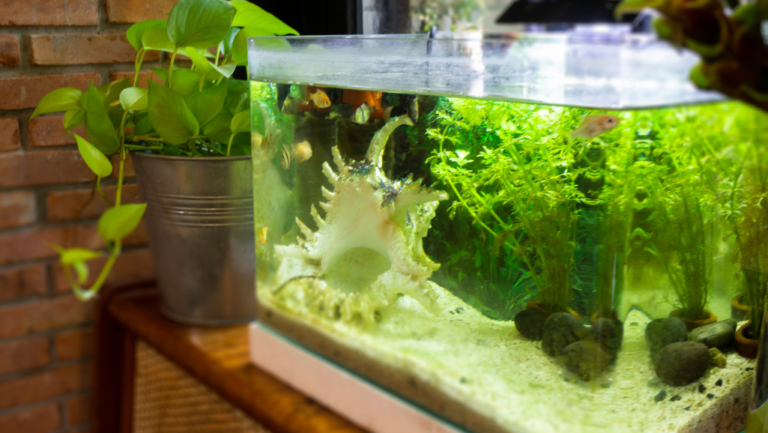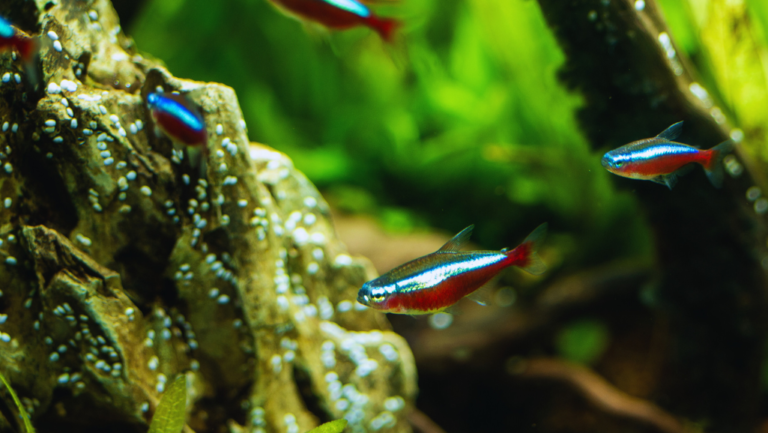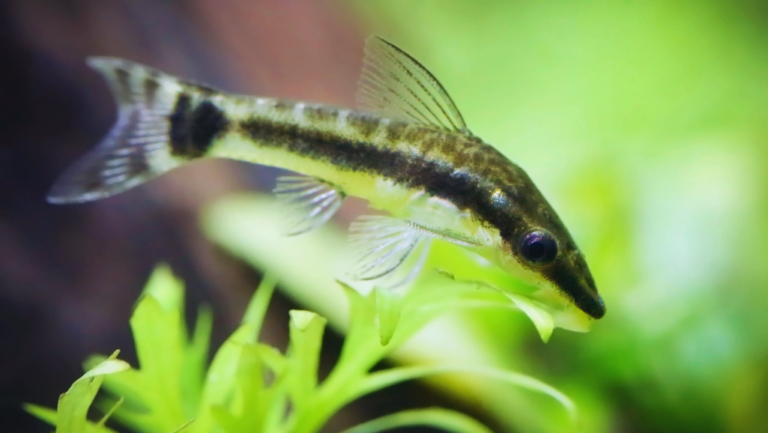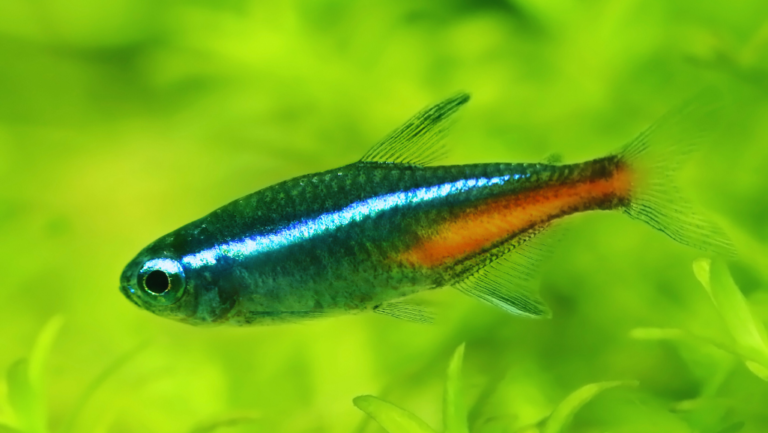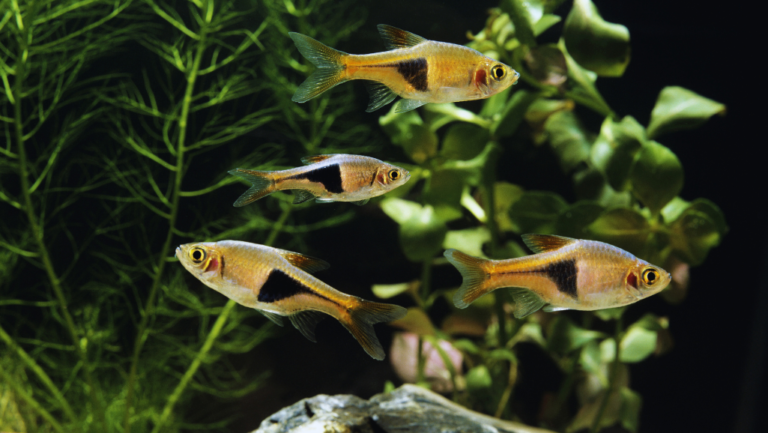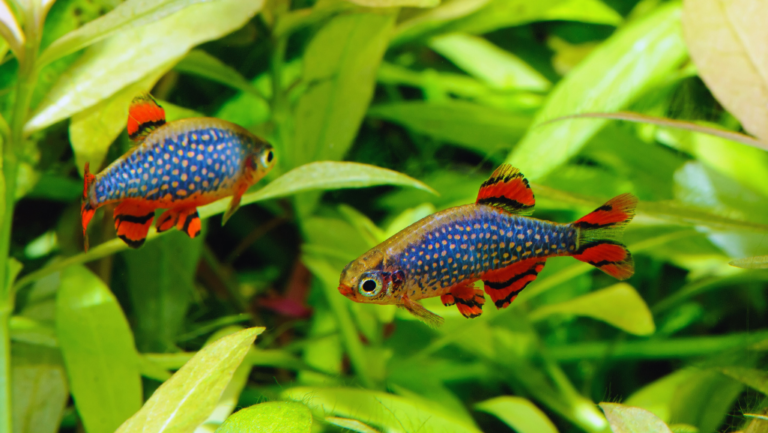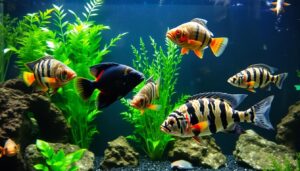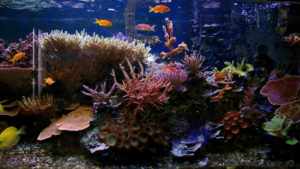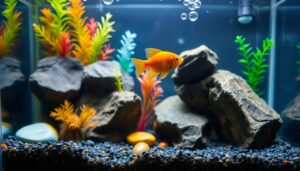Meet the chili rasbora, a tiny jewel for your nano tank that turns a small setup into a living splash of color.
Boraras brigittae comes from the blackwater streams of Borneo and Indonesia and shows a vivid scarlet body above a dark stripe when kept in soft, slightly acidic water.
Adults reach about three-quarters of an inch and do best in dim, well-planted aquariums with dark substrate and gentle flow.
Keep them in groups so the school feels secure and the red coloration deepens. Offer fine foods like crushed flakes, micro pellets, and live micro fare so every fish eats.
Smart setup choices—floating cover, sponge filtration, and prefiltered intakes—protect these small fish and any shrimp you keep with them.
This guide turns wild-habitat cues into simple, practical steps to build a calm, vibrant aquarium that highlights the bright body and lively schooling of mosquito rasboras.
Key Takeaways
- Chili rasboras thrive in dim, planted nano tanks with soft, slightly acidic water.
- Keep them in groups (8–12+) to encourage bold, schooling behavior.
- Use dark substrate, botanicals, and gentle flow to boost red coloration.
- Feed micro-sized foods and protect filters with sponge prefilters.
- With steady care, these small fish can live 4–8 years and pair well with peaceful shrimp.
Why Choose Chili Rasbora for Your Nano Tank
Big color and character in a very small footprint. If you want bold scarlet tones and lively motion without a large setup, these tiny swimmers deliver. They come from shaded, tannin-rich blackwater streams and show their best red when settled in soft, gentle conditions.
Inspiration: Big color and character in a small footprint
Choose chili rasboras when you want maximum color from truly small fish that won’t overwhelm limited space. A planted, low-flow tank with floating cover makes their red hues pop and their schooling display feel natural.
Search intent: What you’ll learn in this step-by-step guide
This guide shows exact water and tank setup, feeding methods for tiny mouths, and how to size a school (6–12+) for confidence and visibility. You’ll also get stocking advice for a peaceful community and tips for pairing with adult shrimp and other nano fish.
- Water and botanicals to flatter red coloration
- Plant choices and gentle equipment for low-stress care
- Practical steps for feeding, health, and breeding
Chili Rasbora
Boraras brigittae packs vivid color and gentle behavior into a tiny, midwater swimmer favored for nano aquariums. Adults stay under an inch, so a small planted tank can showcase their schooling and red tones.
Species snapshot: basics, size, and lifespan
Size: Adults average about 0.7–0.75 inch. Keep them in groups so they feel secure and color improves.
Lifespan: With steady care and clean water, expect 4–8 years.
Male vs. female: coloration, body, and fins
Males are smaller but show deeper red coloration and translucent fins with tiny red spots. Females are slightly rounder and often duller, especially when carrying eggs.
- Recognize the species by its slender body and a dark stripe with scarlet overlay.
- Feed a rotation of crushed flakes, micro pellets, micro worms, and occasional brine shrimp for best condition.
- Gentle flow and tannin-rich water echo their native streams and support calmer behavior.
Setting Up the Aquarium: From Empty Glass to Thriving Nano
A calm, well-planned nano setup turns empty glass into a stable home where tiny schoolers feel confident and show their best color.
Tank size and layout: 5–10 gallons and beyond
Start with at least 5 gallons, but aim for 10 gallons for greater stability and room for a larger school. Use a dark substrate, wood, and leaf litter to recreate blackwater stream levels. Leave open midwater space for schooling and plant the edges for refuge and hiding.
Filtration and flow: gentle choices for safety
Choose a sponge filter for steady, low-flow filtration. If you use a HOB or canister, add a prefilter sponge over the intake to protect tiny fish and shrimp. Break strong currents with wood, plants, or a spray bar so your school glides, not struggles.
Lighting, tannins, and plant selection
Use dim, warm-toned lighting and a dark background to make red tones pop. Add catappa leaves or peat to release tannins that gently tint the water and lower pH a touch. Plant hardy, low-light choices—Anubias, Java fern, crypts, water sprite—and a patch of java moss for cover and potential breeding sites.
Tip: Fully cycle the aquarium before adding fish and test water often in the first weeks to catch rapid swings.
Dialing In Water Parameters
Small tanks demand steady chemistry. Tiny schoolers respond quickly to swings, so focus on predictable, gentle conditions rather than extreme numbers.
Target ranges: temperature, pH, and hardness
Aim for steady warmth in the mid-70s°F (roughly 72–82°F), and gentle acidity near pH 6.0–7.5. Soft water suits many nano setups and helps color show. Pick a point you can maintain and keep it consistent.
Tap, RO, or distilled — conditioning right
If you use tap water, always add a good dechlorinator/conditioner. With RO or distilled water, remineralize so fish and plants have needed minerals. Tannins from catappa leaves or peat can nudge pH lower and calm fish.
Best practices: testing and routine care
Test weekly for ammonia, nitrite, nitrate, pH, and temperature and note trends. Perform 20–30% partial water changes with temperature-matched, conditioned water.
- Rinse sponge filters in removed tank water to keep beneficial bacteria.
- Feed lightly and avoid overstocking to reduce waste and sudden level shifts.
- Consistency is the quiet superpower behind vivid color and relaxed behavior.
Aquascaping for Confidence: Plants, Hiding Spots, and Swim Space
Use low-light plants and soft textures to recreate the shaded streams these tiny fish call home. Start by placing epiphytes like Anubias and Java fern along wood and rock to form vertical shelter. Add rooted crypts and a patch of water sprite to diffuse light and calm the surface.
Introduce java moss or moss thickets as dense cover. A lush moss tuft gives fry and shy fish safe foraging zones and hosts microfauna that help feed shrimp and fry. For intentional breeding, lay a sheet of plastic craft mesh under moss or a spawning mop so eggs can fall out of reach.
Keep open midwater lanes for schooling while framing margins with wood and plants. Dark substrate and warm wood tones amplify red color and make the school stand out without stressing fish.
Tip: Aim for a low-maintenance palette of slow growers so you trim less and keep the tank stable.
- Craft a calm, shaded aquarium with low-light plants that thrive in modest illumination and gentle flow.
- Use java moss thickets and spawning mops for hiding and breeding protection.
- Balance plant mass and open swim space to let the school move freely while staying secure.
Schooling and Stocking Levels
The right group size turns shy individuals into bold, synchronized swimmers in midwater.
As schooling fish, these tiny swimmers need company to thrive. Plan for a minimum of six, but aim for 8–12 chili rasboras to unlock confident schooling and frequent midwater displays.
A 10-gallon tank is a sweet spot for stability and space. Larger volumes let you expand the school and still keep water steady.
Stock lightly beyond the school; small fish add little bioload, yet restraint preserves water quality in nano setups. Add new rasboras in small batches so filters and biology adjust without parameter swings.
“Observe behavior as your guide—tight schooling and frequent appearances indicate the group feels safe.”
- Watch appetite and color—healthy fish in a proper size group show both.
- Match school size to aquascape; leave open lanes for synchronized movement.
- Choose gentle tank mates that protect the school’s confidence and reduce stress.
- Prioritize a larger school over extra species to showcase the signature shimmer of these nano fish.
Food and Feeding Strategy
Feed with purpose: planned meals and protein boosts keep small schooling fish vibrant and active.
Daily staples
Build each day around finely crushed flakes and micro pellets that float or suspend in midwater. These staples mimic the tiny particles the fish pick from the water column in the wild.
Protein power-ups
Add live or frozen treats like baby brine shrimp, micro worms, cyclops, and Daphnia several times weekly. These high-protein items boost conditioning and encourage natural hunting behavior.
Feeding technique
Scatter small portions 2–3 times daily so the school grazes without spikes in waste. Use slow-sinking, finely sized particles so timid individuals and shrimp can access food.
Color-up plan
Prioritize quality proteins and carotenoid-rich items to deepen red tones in chili rasboras over time. Rinse live foods as needed and keep a short log of meals and responses to fine-tune care.
“Disperse food widely so shy fish aren’t outcompeted.”
Peaceful Community: Compatible Tank Mates
Build a peaceful community by choosing small, calm species that match the gentle temperament and water needs of boraras brigittae.
Great companions include ember tetras, lambchop and neon green rasboras, dwarf Corydoras, rosy loaches, snails, and adult shrimp. These tank mates are similarly sized and unlikely to outcompete your school for food.
What to avoid
Avoid larger, aggressive species that may harass or eat tiny fish. Fast, bold feeders can stress the school and steal food meant for midwater grazers.
Practical tips for harmony
- Provide dense plants, floating cover, and plenty of hiding spots so shy individuals and baby shrimp get refuge.
- Expect opportunistic snacking on fry; if you plan on breeding, add moss and mesh to protect eggs.
- Introduce new tank mates slowly and watch behavior and appetite to keep the community calm.
“Understock and over-plant: a calmer, greener tank supports better color and long-term harmony.”
For more on compatible choices and setup pointers, see care and community choices.
Behavior and Care: What to Expect Day to Day
Observe a calm, synchronized school that often cruises the upper to midwater once the group feels secure. These fish start timid after a move but grow bolder in numbers and familiar surroundings.
Keep current low so they conserve energy and protect delicate fins. Strong flow stresses the school and can dull color for days to weeks.
New arrivals may pale or hide. With steady care and stable water, vivid tones return in a week or two.
Feed tiny portions of fine foods multiple times daily. Add an occasional boost of brine shrimp or worms to improve condition without fouling a small tank.
“Read the school’s body language—tight shoaling, reduced appetite, or flashing spots can flag stress.”
Maintain consistent water parameters, lighting, and feeding times. Provide shaded resting zones under floaters and plant beds so the species feels safe.
- Watch daily at the same time to learn normal patterns.
- Use gentle maintenance—soft sponge cleaning and temperature-matched changes.
- Celebrate signs of thriving: curious approaches, steady grazing, and a cohesive school.
Breeding Chili Rasboras at Home
Successful breeding begins with a calm, mature aquarium that mimics shaded blackwater streams. This gives adults confidence and a steady supply of microfauna for fry. Use a dedicated tank with botanicals, leaf litter, and established biofilm.
Conditioning adults for spawning
Condition the group with high-quality live foods like baby brine shrimp and micro worms. Keep water slightly acidic and pristine to signal readiness. Feed small, protein-rich portions twice daily to boost color and fertility.
Protecting scattered eggs
Lay a plastic craft mesh on the tank bottom and top it with dense java moss or a yarn spawning mop. Dense cover catches falling eggs and shelters them from adults.
Remove adults after spawning or at first sight of fry; even attentive keepers lose eggs to parents.
Raising fry: stepwise food plan
Start fry on infusoria or vinegar eels for the first week. After about ten days, add micro worms and then graduate to baby brine shrimp.
- Keep filtration ultra-gentle with a sponge filter and tiny bubbles.
- Use a mature planted tank so microfauna provides constant grazing.
- Feed tiny amounts multiple times daily and do small, frequent water changes.
“Patience and steady micro foods create a rewarding trickle of new life.”
Health, Diseases, and Prevention
A calm daily routine and clean water are your strongest defenses against common ailments. Watch your aquarium closely so you spot problems early. Tiny fish show trouble quickly when levels shift or stress rises.
Common issues include Ich (white spots), velvet (a golden dusting), frayed fins from fin rot, and bacterial infections such as columnaris. Nitrite sensitivity can hurt small schoolers fast. Look for white spots, a golden sheen, ragged fins, or cottony patches.
Prevention first
- Keep water clean and stable with routine testing and modest feeding.
- Quarantine new fish, shrimp, and plants to avoid introducing pathogens.
- Reduce stress with dim light, gentle flow, and plenty of cover.
- Maintain a healthy filter and steady maintenance rhythm tailored to small tanks.
Treatment basics
Treat Ich with slow heat increase and aquarium-safe salt where appropriate; escalate to targeted meds if needed. Use copper or formalin products carefully for velvet. Apply antibiotics for fin rot or columnaris when water tests are stable and oxygen is ample.
“During treatment, keep aeration high, do small frequent water changes, and log symptoms and test results.”
After recovery, gently restore beneficial bacteria with measured filter care and reduced feedings. Prevention and steady care protect color, fins, and long-term vitality in rasbora communities.
Conclusion
With simple routines and the right companions, these tiny fish reward steady care with lively, confident schooling.
Use this guide to build a calm nano tank that highlights chili rasbora and their ruby color. Aim for dim light, tannins, gentle flow, and stable water to keep stress low.
Focus on fine foods, a proper school size, and lots of cover so behavior and color improve. Pair with peaceful shrimp and small companions to keep harmony long term.
For breeding, a mesh bottom and moss thickets offer an easy nursery. Stay consistent with small, regular maintenance and you’ll enjoy the daily spectacle of Boraras brigittae in a serene planted aquarium.
